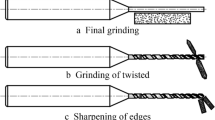Abstract
The problem of eliminating edge-chipping at the entrance and exit of the hole while drilling brittle materials is still a challenging task in different industries. Grinding-aided electrochemical discharge machining (G-ECDM) is a promising technology for drilling advanced hard-to-machine ceramics, glass, composites, and other brittle materials. Edge-chipping at the entrance of the hole can be fully eliminated by optimizing the machining parameters of G-ECDM. However, edge-chipping at the exit of the hole is difficult to eliminate during the drilling of ceramics and glass. This investigation suggests some practical ways to reduce edge-chipping at the exit of the hole. For this purpose, a three-dimensional finite element model was developed, and a coupled field analysis was conducted to study the effect of four parameters, i.e., cutting depth, support length, applied voltage, and pulse-on time, on the maximum normal stress in the region where the edge-chipping initiates. The model is capable of predicting the edge-chipping thickness, and the results predicted by the model are in close agreement with the experiment results. This investigation recommends the use of a low voltage and low pulse-on time at the hole entrance and exit when applying G-ECDM to reduce the edge-chipping thickness. Moreover, the use of a full rigid support in the form of a base plate or sacrificial plate beneath the workpiece can postpone the initiation of chipping by providing support when the tool reaches the bottom layer of the workpiece, thereby reducing the edge-chipping thickness.



















Similar content being viewed by others
References
Jain VK, Choudhury SK, Ramesh KM (2002) On the machining of alumina and glass. Int J Mach Tools Manuf 42:1269–1276
Sanjay KC, Venkateswara RP (2008) The drilling of Al2O3 using a pulsed DC supply with a rotary abrasive electrode by the electrochemical discharge process. Int J Adv Manuf Tech 39:633–641
Liu JW, Yue TM, Guo ZN (2013) Grinding-aided electrochemical discharge machining of particulate reinforced metal matrix composites. Int J Adv Manuf Tech 68:2349–2357
Ladeesh VG, Manu R (2016) Grinding aided electrochemical discharge drilling (G-ECDD) of borosilicate glass and its performance evaluation. Proc Technol 25:1122–1128
Chak SK, Rao PV (2007) Trepanning of Al2O3 by electro-chemical discharge machining (ECDM) process using abrasive electrode with pulsed DC supply. Int J Mach Tools Manuf 47:2061–2070
Jiang BY, Lan SH, Ni J et al (2014) Experimental investigation of spark generation in electrochemical discharge machining of non-conducting materials. J Mater Process Technol 214:892–898
Harry K, Raoul R, Konrad W (2013) Experimental investigation and simulation of heat flux into metallic surfaces due to single discharges in micro-electrochemical arc machining (micro-ECAM). Int J Adv Manuf Tech 68:1267–1275
Jana D, Abou Z, Wuthrich R (2012) Tool wear and tool thermal expansion during micro-machining by spark assisted chemical engraving. Int J Adv Manuf Tech 61:481–486
Jain VK, Dixit PM, Pandey PM (1999) On the analysis of the electrochemical spark machining process. Int J Mach Tools Manuf 39:165–186
Wang JJ, Feng PF, Zhang JF et al (2016) Modeling the dependency of edge chipping size on the material properties and cutting force for rotary ultrasonic drilling of brittle materials. Int J Mach Tools Manuf 101:18–27
Wang JJ, Feng PF, Zhang JF et al (2016) Investigations on the edge-chipping reduction in rotary ultrasonic machining using a conical drill. Proc IMechE B J Eng Manuf 230(7):1254–1263
Zhang C, Cong W, Feng P et al (2014) Rotary ultrasonic machining of optical K9 glass using compressed air as coolant: a feasibility study. Proc IMechE B J Eng Manuf 228(4):504–514
Liu JW, Baek DK, Ko TJ (2014) Chipping minimization in drilling ceramic materials with rotary ultrasonic machining. Int J Adv Manuf Technol 72:1527–1535
Chai H, Brian RL (2007) A universal relation for edge chipping from sharp contacts in brittle materials: a simple means of toughness evaluation. Acta Mater 55:2555–2561
Wang JJ, Feng PF, Zhang JF et al (2016) On the mechanism of edge chipping reduction in rotary ultrasonic drilling: a novel experimental method. Precis Eng 44:231–235
Dhondt G (2004) The finite element method for thermo-mechanical applications. Wiley, New York
Bhondwe KL, Yadava V, Kathiresan G (2006) Finite element prediction of material removal rate due to electro-chemical spark machining. Int J Mach Tools Manuf 46:1699–1706
Zmindak M, Novak P, Nozdrovicky J (2008) Thermo-mechanical transient analysis of concrete structure around the nuclear reactor. Appl Comput Mech 2:409–418
Theory reference for ANSYS and ANSYS workbench (2007) ANSYS release 11. ANSYS Inc.
Acknowledgement
The authors would like to acknowledge the financial support provided by Kerala State Council for Science Technology and Environment (KSCSTE) through Technology Development and Adaptation Programme (Grant No. 935/2015/KSCSTE) for the successful implementation of this study.
Author information
Authors and Affiliations
Corresponding author
Rights and permissions
About this article
Cite this article
Ladeesh, V.G., Manu, R. Effect of machining parameters on edge-chipping during drilling of glass using grinding-aided electrochemical discharge machining (G-ECDM). Adv. Manuf. 6, 215–224 (2018). https://doi.org/10.1007/s40436-017-0194-5
Received:
Accepted:
Published:
Issue Date:
DOI: https://doi.org/10.1007/s40436-017-0194-5




